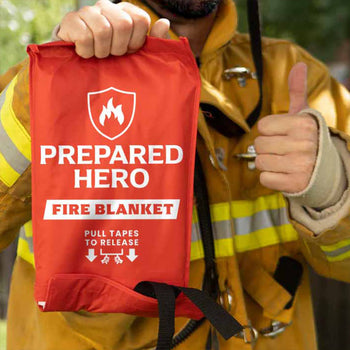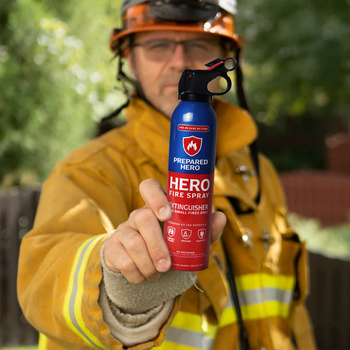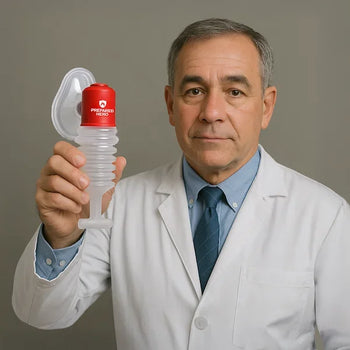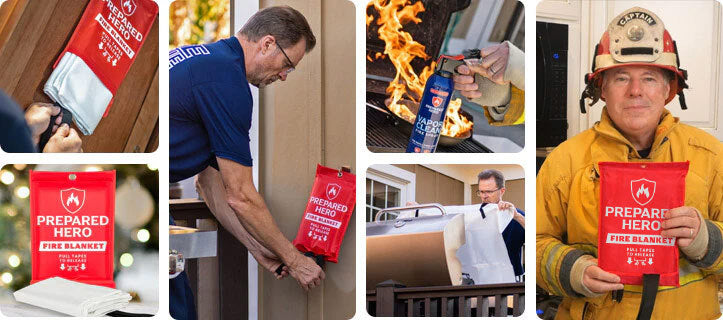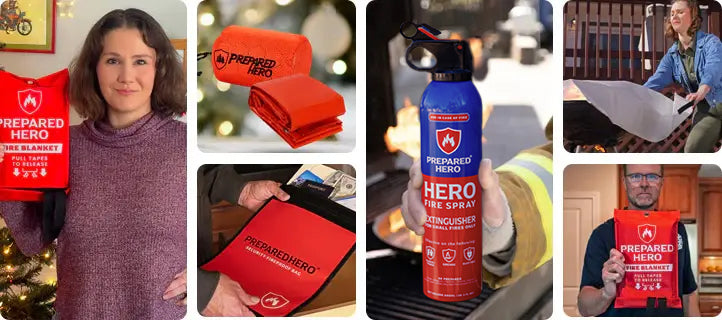Where you put your smoke detectors matters just as much as installing them. Proper placement makes sure they can detect...
Class D fires may not occur as often as the other fire types, but they’re more dangerous. You see, they’re caused by metals that can burn up to 5,610 °F or 3,099 °C. Plus, you can’t use many multi-purpose or ABC fire extinguishers to put them out. Water won’t help either.
Metal fires call for Class D fire extinguishers. But how exactly do they work? What are they made of? How do you use them properly?
In this guide, we’ll go over how Class D fires work, what they’re made of, and how to use them. We’ll also talk about more affordable and lightweight alternatives that are just as effective as Class D fire extinguishers.
What Is a Class D Fire Extinguisher?

Class D fire extinguishers are made to put out fires involving metals. Metal fires are tricky to put out because they involve metals with extremely high burning temperatures. They’re caused by metals found in industrial settings, offices, and homes. These metals include the following:
- Lithium
- Magnesium
- Aluminum
- Titanium
- Sodium
- Potassium
- Zinc
- Beryllium
Certain metals, like sodium, potassium, and magnesium, can react violently with water and lead to explosions. For instance, when sodium or potassium comes into contact with water, they produce hydrogen gas and a strong alkaline solution. This process generates heat that can ignite the hydrogen. While magnesium doesn’t react with water at room temperature, it can react with steam to produce magnesium oxide and hydrogen, which produce heat and flames. Hence, using water on this type of fire is extremely dangerous.
Metal fires are difficult to put out, so there’s just one type of fire extinguisher you can use: dry powder. Dry powder extinguishers are designed to smother the flames while preventing a dangerous reaction between the fire and metal. Always be prepared and put your Class D extinguisher in an accessible spot, especially if there are combustible metals around you.
What Is a Class D Fire Extinguisher Used For?

A Class D fire extinguisher is your ultimate weapon against dangerous metal fires. Here are the most common metals you should use Class D fire extinguishers on:
Lithium
Lithium is a soft, silvery metal with high reactivity. It’s commonly used in rechargeable batteries for smartphones, laptops, and electric vehicles. Lithium batteries can catch fire if they overheat or get damaged. They also release toxic fumes during the process. For these reasons, they should be handled carefully, especially during charging or disposal.
Plus, lithium batteries are the most common batteries used all over the globe. Plus, projections state that the demand for lithium batteries will increase by seven times in the next six years.
Magnesium
Magnesium is a lightweight metal that’s highly flammable, especially in powder form. It’s commonly used in aerospace applications, automotive parts, and alkaline batteries. Magnesium can ignite quickly when exposed to excessive heat, sparks, or flames. For example, magnesium shavings can easily catch fire if a nearby machine produces sparks.
Aluminum
Aluminum is widely used in packaging, automotive components, and construction materials. While aluminum is generally safe, aluminum powder, shavings, and dust quickly ignite when exposed to heat. A Class D fire could occur if aluminum dust is present and someone’s welding near it.
Titanium
Titanium is a strong and lightweight metal commonly used to make aerospace parts and medical implants. While it’s not as prone to catching fire as other metals on this list, titanium can burn in powder form or when mixed with certain chemicals called oxidizers. For instance, titanium dust can ignite if it comes into contact with enough heat, which calls for a Class D fire extinguisher.
Sodium
Sodium can react violently with moisture. It’s commonly used in manufacturing facilities. When sodium comes into contact with water, it can ignite and cause an explosion. Sodium leaks or spills can be dangerous, so they should be handled with extreme caution. A Class D fire extinguisher is also a must in any place with sodium.
Potassium
Like sodium, potassium is a highly reactive metal. It can spontaneously ignite when exposed to water. It’s often found in fertilizers and used to produce potassium hydroxide used in soap-making. Even small amounts of moisture can trigger a fire, so you better have a Class D fire extinguisher ready.
Zinc
Zinc is a bluish-white metal typically used for galvanizing steel and battery production. Zinc powder can start a fire if dispersed in the air and comes into contact with heat. For instance, zinc powder can ignite in foundries, where people work at extremely high temperatures.
Beryllium
Beryllium is a hard, lightweight metal used to make aerospace components, electrical contacts, medical devices, and certain alloys. Like other metals on this list, it can start a Class D fire when in powder form. Exposure to beryllium powder can also cause lung scarring, shortness of breath, and fatigue.
What Is a Class D Fire Extinguisher Made Of?

Class D fires are dangerous and specialized fires that can only be put out by dry powder. This dry powder is usually a blend of powdered graphite, sodium chloride granules, and copper fragments.
When sprayed on top of a Class D fire, the dry powder creates a barrier between the metal and the oxygen in the air. This helps absorb some of the heat, reduces the fire’s intensity, and eventually puts out the Class D fire.
Take note that Class D dry powder fire extinguishers cannot be used on other types of fire. They’re specifically made for Class D fires and should not be mistaken for powder fire extinguishers that you can use on Class A, B, and C fires.
How to Identify Class D Fire Extinguishers
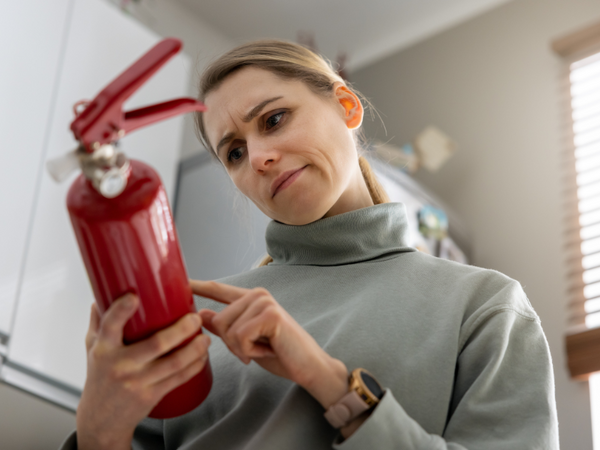
Class D fire extinguishers have a specific symbol: a yellow star with the letter D inside it. The yellow star indicates that the extinguisher can put out fires caused by combustible metals like lithium, magnesium, sodium, aluminum, and titanium. If you see a star with a D, it’s the right extinguisher for a metal fire.
Remember, you cannot use multi-purpose extinguishers to put out Class D fires. These fire extinguishers are designed to put out Class A, B, and C fires only. Water won’t do either because some metals, like sodium and potassium, violently react with it.
According to the National Fire Protection Agency (NFPA), extinguishers and agents used on metal fires are rated based on the amount of agent used and the application method needed to control the fire.
How to Use a Class D Fire Extinguisher

A Class D fire extinguisher is your first line of defense against dangerous metal fires. But there’s no point having one if you don’t know how to use it. Even if you don’t undergo special training to use a fire extinguisher, you can still put a Class D fire out. Just be familiar with the PASS fire extinguisher technique.
PASS stands for Pull, Aim, Squeeze, and Sweep. Safety experts made this acronym so everyone can remember the four basic steps to use a fire extinguisher. While some extinguishers have specific guidelines, PASS is the basic protocol for using all fire extinguishers. By being familiar with PASS, you can use your Class D fire extinguisher correctly. This approach also makes you more confident about putting out a fire. Here’s a closer look at what PASS stands for:
Pull: Pull the Class D fire extinguisher’s safety pin to use the trigger.
Aim: Aim the hose at the base of the metal fire.
Squeeze: Squeeze the handle or lever to release the dry powder.
Sweep: Sweep the hose from side to side until the fire is out.
Please note that PASS is just one part of extinguishing a metal fire. You should also know whether it’s safe to put out the fire or not. You may know how to use a Class D fire extinguisher, but if the fire is too large and it explodes, it’s not safe to fight it.
Always prioritize yourself and others. While you may be tempted to put out the metal fire, it’s sometimes safer to evacuate and call the fire department.
How to Maintain Class D Fire Extinguishers

Keeping your Class D fire extinguisher in top shape ensures it will work against combustible metal fires.
Begin with doing regular checks. Inspect your Class D fire extinguisher every month to see any signs of damage. Is the safety pin in place? Does the pressure gauge point to the green zone? What about the lever, nozzle, and hose? Answering these questions lets you determine if your Class D fire extinguisher needs to be replaced or refilled.
Asking a professional to inspect your Class D fire extinguisher at least once a year is also a great idea. They can check your Class D extinguisher thoroughly and make sure it meets standards and regulations.
Your Class D fire extinguishers should undergo hydrostatic testing as well. In general, they have to be tested every 12 years. However, you should stick to specific manufacturer guidelines if they say otherwise.
When to Replace Class D Fire Extinguishers

Imagine having a Class D fire extinguisher that doesn’t work when you need it the most. Prevent this from happening by knowing when to replace your Class D fire extinguisher.
1. Your Class D fire extinguisher is expired.
The first sign is simple: your Class D fire extinguisher has expired. You can see the expiration date on the container, and even if you haven’t used your Class D fire extinguisher before that date, you should replace it. The expiration date may also come sooner because it depends on many factors, including the extinguishing agent and how it’s stored. Remember, it’s not safe to use an expired fire extinguisher because it might not work and put everyone in danger.
2. Your Class D fire extinguisher is damaged.
Watch out for these signs of physical damage:
- Dents
- Loose handle or hose
- Broken safety pin
- Rust or corrosion
- Cracked hose
Dents on a Class D fire extinguisher indicate the container is weak or was mishandled. Meanwhile, a broken safety pin means the fire extinguisher could discharge by itself, leaving you with an empty container.
On the other hand, a loose handle or hose makes it hard to aim the agent at the base of the fire. Lastly, rust or corrosion indicates malfunctioning components and ruptured cylinders.
3. Your fire extinguisher has low pressure.
A fire extinguisher’s pressure gauge prevents you from using your Class D fire extinguisher when its pressure is low.
Having enough pressure ensures that the dry powder will come out with enough force to put out the metal fire. If the pressure is too low, the dry powder might not come out with the right force or not at all.
4. Regulations or the environment changed.
Fire safety authorities update regulations and standards to keep people and properties safe. Following these updates ensures that your Class D fire extinguishers meet the requirements set by experts.
Plus, your environment and the fire hazards around you might change. For instance, if you transfer from a place without a workshop to a house with one, you need more Class D fire extinguishers. Always check if your fire extinguishers can put out the types of fire that could occur in your house. If not, replace or add to them.
How Much Are Class D Fire Extinguishers?

Class D fire extinguishers are more expensive than other types of fire extinguishers because of the chemicals needed to make them. They also come in large containers to make sure you have enough extinguishing agent to put out a metal fire. Class D fire extinguishers weighing at least 30 lbs usually cost $800 to $1,200.
Class D Fire Extinguisher Alternatives

While Class D fire extinguishers put out metal fires quickly, they are expensive, heavy, bulky, and hard to store. They might also contain toxic chemicals and leave residues that are hard to clean up. Please take note that you can only use the alternatives below if the metal’s ignition temperature is lower than what the fire spray or fire blanket can withstand.
A fire spray is an easy-to-use, lightweight, and affordable alternative to Class D fire extinguishers. Prepared Hero’s fire spray is also biodegradable and non-toxic. Unlike a fire extinguisher, you can safely use it around your family and pets.
Here’s a table summarizing the differences between Prepared Hero’s fire spray and a regular Class D fire extinguisher:
|
Prepared Hero’s Fire Spray |
Regular Fire Extinguisher |
|
Lightweight, easy to carry |
Heavy, hard to carry |
|
Affordable |
Very expensive |
|
Easy to store |
Needs more space for storage |
|
100% biodegradable |
Mostly made of non-biodegradable materials |
|
Non-toxic |
Toxic |
|
Easy to clean |
Hard to clean |
|
Safe for kids and pets |
Not safe for kids and pets |
Another alternative is a fire blanket, which removes the fire’s oxygen supply. By doing this, it puts out small Class D fires. It also doesn’t leave a mess because it just covers the fire.
Unlike fire extinguishers, Prepared Hero’s fire blanket doesn’t expire. You can reuse it as many times as you want as long as it’s not damaged. Plus, you can use it to save someone on fire.
Here’s a table summarizing the differences between Prepared Hero’s fire blanket and a regular Class D fire extinguisher:
|
Prepared Hero’s Fire Blanket |
Regular Fire Extinguisher |
|
Lightweight, easy to carry |
Heavy, hard to carry |
|
Affordable |
Expensive |
|
Doesn’t expire |
Expires |
|
Easy to store |
Needs more space for storage |
|
Non-toxic |
Toxic |
|
Doesn’t leave a mess |
Leaves a mess |
|
Safe for kids and pets |
Not safe for kids and pets |
|
Can be used on humans |
Can’t be sprayed on humans |
Do you want reliable, easy-to-use, and affordable tools to put out Class D fires? Check out Prepared Hero’s fire prevention tools here, and get up to 51% off on certain items. Stay prepared, hero!


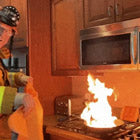 Fire
Fire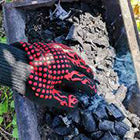 Safety
Safety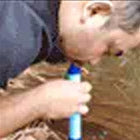 Survival
Survival Protection
Protection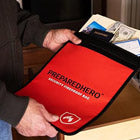 New
New
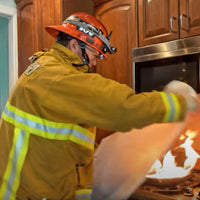 Fire
Fire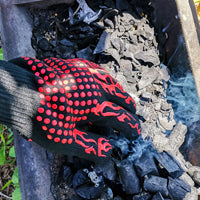 Safety
Safety Survival
Survival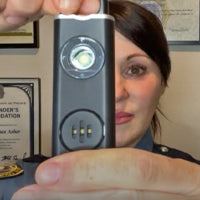 Protection
Protection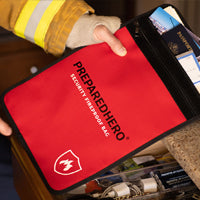 New
New
